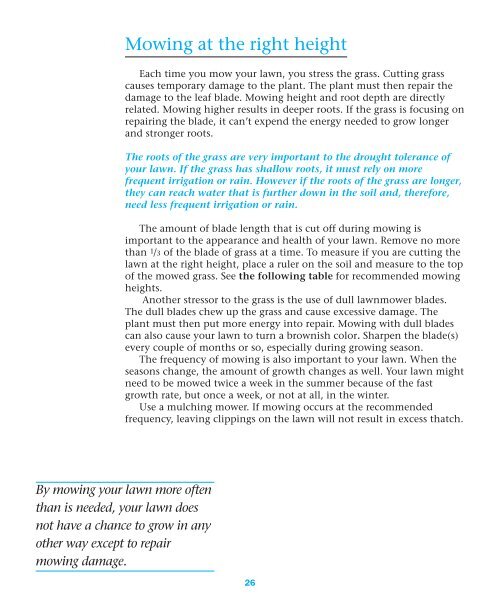What You Need to Know About Fertilizing and Watering - Southwest ...
What You Need to Know About Fertilizing and Watering - Southwest ...
What You Need to Know About Fertilizing and Watering - Southwest ...
Create successful ePaper yourself
Turn your PDF publications into a flip-book with our unique Google optimized e-Paper software.
Mowing at the right height<br />
Each time you mow your lawn, you stress the grass. Cutting grass<br />
causes temporary damage <strong>to</strong> the plant. The plant must then repair the<br />
damage <strong>to</strong> the leaf blade. Mowing height <strong>and</strong> root depth are directly<br />
related. Mowing higher results in deeper roots. If the grass is focusing on<br />
repairing the blade, it can’t expend the energy needed <strong>to</strong> grow longer<br />
<strong>and</strong> stronger roots.<br />
The roots of the grass are very important <strong>to</strong> the drought <strong>to</strong>lerance of<br />
your lawn. If the grass has shallow roots, it must rely on more<br />
frequent irrigation or rain. However if the roots of the grass are longer,<br />
they can reach water that is further down in the soil <strong>and</strong>, therefore,<br />
need less frequent irrigation or rain.<br />
The amount of blade length that is cut off during mowing is<br />
important <strong>to</strong> the appearance <strong>and</strong> health of your lawn. Remove no more<br />
than 1 /3 of the blade of grass at a time. To measure if you are cutting the<br />
lawn at the right height, place a ruler on the soil <strong>and</strong> measure <strong>to</strong> the <strong>to</strong>p<br />
of the mowed grass. See the following table for recommended mowing<br />
heights.<br />
Another stressor <strong>to</strong> the grass is the use of dull lawnmower blades.<br />
The dull blades chew up the grass <strong>and</strong> cause excessive damage. The<br />
plant must then put more energy in<strong>to</strong> repair. Mowing with dull blades<br />
can also cause your lawn <strong>to</strong> turn a brownish color. Sharpen the blade(s)<br />
every couple of months or so, especially during growing season.<br />
The frequency of mowing is also important <strong>to</strong> your lawn. When the<br />
seasons change, the amount of growth changes as well. <strong>You</strong>r lawn might<br />
need <strong>to</strong> be mowed twice a week in the summer because of the fast<br />
growth rate, but once a week, or not at all, in the winter.<br />
Use a mulching mower. If mowing occurs at the recommended<br />
frequency, leaving clippings on the lawn will not result in excess thatch.<br />
By mowing your lawn more often<br />
than is needed, your lawn does<br />
not have a chance <strong>to</strong> grow in any<br />
other way except <strong>to</strong> repair<br />
mowing damage.<br />
26
















